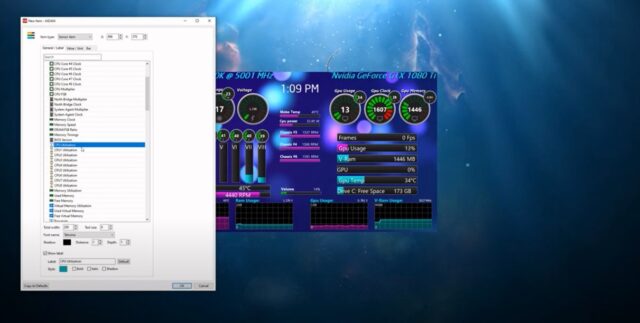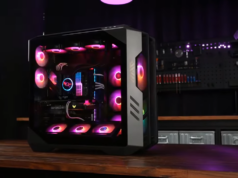
Keeping your computer cool and quiet is essential for optimal performance, as too much heat can cause loud fan noise and reduce its lifespan.
Fortunately, there are a variety of free fan control software options available for Windows 10 to manage the cooling system of your PC.
While most are effective at reducing noise, some may provide features such as automatic speed adjustment based on operational load levels or programmable cooling profiles to target individual components.
By selecting the right fan control software for your setup, you can ensure that everything runs smoothly and quietly while keeping your components operating at their best temperatures. Read on as we discuss ten top fan control software options to help keep your PC cool and quiet!
Top 10 Best Software Options for Managing Your Fan Speeds
Fan control software is used to monitor your PC’s internal temperature and control the speed of your fans accordingly. It’s important to control the speed of your fans to reduce the risk of overheating and maintain the internal temperature of your system.
1. Speed Fan
It is one of the most popular software available for Windows. It can be used to automatically adjust system fan speeds based on the current CPU and HDD temperatures.
SpeedFan monitors the speed of your CPU’s fan, as well as your hard disk, GPU and other components.
The software is an easy to use interface that allows you to monitor and adjust your fan speeds from within Windows. You can easily create custom profiles, set up temperature alarms and trigger events when certain levels are reached.
It also includes a built-in feature for controlling the speed of your external devices like USB hubs or Bluetooth receivers. It is available for free and it supports all versions of Windows from 7 onward.
2. HWMonitor
HWMonitor provides users with a comprehensive hardware monitoring tool that can read out temperatures, fan speeds and more. The application is designed to gauge the health and stability of your computer, so it helps to regulate the temperature and other inner processes as well.
This helps in offering an unobtrusive cooling mechanism for your computer, making sure it runs smoothly for longer durations and preventing any performance hindrances that could arise due to overheating components.
The helpful aspect of this tool is the various visuals it has that are indicative of how your PC is doing — you can view charts of data related to voltage, temperature and fan speed in real-time as well as keep track of changes in other parameters.
Additionally, HWMonitor takes advantage of system tray notifications to alert you when certain conditions arise. The software also supports monitoring for different types of systems including Intel Socket LGA 1156/1155/1150 and AMD Socket FM2+/FM2/FM1/AM3+/AM3/AM2+/AM2 processors.
3. Argus Monitor
Argus Monitor is designed to monitor temperature and other key components in order to maintain optimum performance. This Windows-based software can intelligently increase and decrease the speed of it depending on your specified settings.
For instance, you can easily create a custom profile that sets the fan speed manually or automatically when the CPU temperature reaches a specific threshold.
Argus Monitor also boasts an efficient system tray application that allows you to keep track of various processes and temperatures in real-time, quickly launching small handy applications as needed.
More advanced users may appreciate the detailed logging function which records any temperature changes over time. The Graph View feature is especially useful, allowing you to view all temperatures at once so you can pinpoint any anomalies quickly and easily.
4. Open Hardware Monitor
Open Hardware Monitor is for Windows and it can be used to monitor temperature sensors, fan speeds, and voltages of computer components. It is capable of monitoring CPU and GPU temperatures, as well as graphics card clock frequencies and voltage levels. You can configure it to run specific programs or applications when temperatures reach a certain level.
Open Hardware Monitor has a user-friendly interface that displays all key information on one screen, which makes it easy to keep track of your hardware’s performance. The software is available for free and can be downloaded directly from the developer’s website.
With Open Hardware Monitor you are able to set overclock settings, control fan speed to keep temperatures at optimal level while playing games or performing resource heavy tasks.
Additionally, you are able to save different profiles for future use, so when you launch a game or any other application with different hardware requirements can set the right profile settings right away.
5. HWiNFO
HWiNFO is a powerful and comprehensive hardware diagnostic tool that is designed to provide users with detailed information about their computer’s hardware components. It can monitor various aspects of your system, such as temperature, voltage, fan speed, and power consumption, among others.
This software is compatible with a wide range of hardware components, including CPUs, GPUs, motherboards, and storage devices, among others.
With its user-friendly interface and real-time monitoring capabilities, HWiNFO allows you to keep an eye on your system’s performance and health, making it an essential tool for enthusiasts, overclockers, and professionals.
In addition to its monitoring features, HWiNFO also includes various customization options that allow you to tweak your system’s settings for optimal performance. For instance, you can adjust fan speeds and create custom fan profiles to keep your system cool and quiet.
You can also configure alerts and notifications to be notified of any hardware-related issues or anomalies. Moreover, the software can generate detailed reports about your system’s hardware components, which can be useful for troubleshooting, benchmarking, or system auditing.
6. Core Temp
Core Temp is a free tool for monitoring CPU temperature. It provides an extremely accurate temperature reading with almost no impact on system performance. This fan control software works on any Intel or AMD processor and displays the exact temperature of each core as reported by the processor’s built-in thermal sensors.
Core Temp also comes with a suite of features that allow users to view charts and graphs of their PC’s current and past temperatures, customize fan profiles, set minimum or maximum temperatures, and save custom settings in profiles.
Core Temp is available as a lightweight but powerful desktop app as well as an equally feature-packed smartphone app. Both versions support up to 64-core systems so you can keep your multi-core PC cool even when working at intensive load levels.
7. MSI Afterburner
MSI Afterburner is a free, popular and widely-used fan control software for Windows operating systems. This software gives users complete control over their fans, allowing them to effortlessly tune their fan speeds for optimal performance or reduced noise. It also supports user profiles, so you can easily access different settings when needed.
MSI Afterburner also has tools that allow you to monitor system temperatures, voltages and more in order to better understand how your system is functioning.
It even allows you to customize an on-screen display which will show you different information tailored to what kind of tasks your computer is handling at any given time. All in all, it’s a great tool for any PC enthusiast who wants complete control of their cooling fans.
8. Real Temp
Real Temp is a powerful fan control software that allows you to monitor temperature sensors located on the CPU and is designed to prevent your computer from overheating. This is especially important if you are running heavy applications or gaming.
The software also comes with a simple user interface that explains what each parameter means, so even those without technical knowledge can apply settings to the software with ease.
It also tracks core temperatures, voltage regulation and frequency of your processor, as well as providing overall system load information.
By providing clear visuals of these performance metrics at a glance, you can easily tweak settings to maximize performance and levels of cooling.
Not only does this help keep your PC quiet and cool during extensive usage, but it also ensures longevity of its hardware by protecting it from heat damage and burn-out.
9. AIDA64
AIDA64 is a comprehensive system diagnostics and benchmarking software that provides detailed information about your computer’s hardware and software components.
This software is designed for Windows operating systems and can be used to identify hardware issues, optimize system performance, and monitor system stability.
One of the most notable features of AIDA64 is its ability to provide accurate and detailed information about your computer’s components, including CPU, motherboard, memory, and storage devices.
It can also display information about the software installed on your computer, such as the operating system, drivers, and applications. Additionally, AIDA64 can monitor various system parameters, including temperature, fan speed, voltage, and power consumption, which can be helpful in identifying issues with your computer’s cooling system.
Another useful feature of AIDA64 is its benchmarking capability. The software can perform various types of benchmarks, such as CPU, memory, disk, and GPU benchmarks, to measure the performance of your computer’s components. This can be helpful in identifying any bottlenecks in your system and optimizing its performance.
10. NZXT
This software provides real-time monitoring of your system’s temperature, fan speeds, and other critical metrics, giving you the ability to adjust settings on the fly to keep your PC running smoothly.
With its sleek and user-friendly design, CAM makes it easy to manage your system’s fans and temperature profiles, ensuring that your PC stays cool and quiet even under heavy loads.
One of the standout features of CAM is its ability to create custom fan profiles based on specific system requirements. This feature allows you to optimize fan speeds based on CPU and GPU usage, ensuring that your system stays cool and quiet during intensive tasks. You can also set up alerts and notifications to be informed of any issues or anomalies, allowing you to take action before they become a more significant problem.
CAM also includes a wide range of customization options, allowing you to tailor your fan profiles to your specific needs. For example, you can adjust fan speeds, create custom temperature curves, and set up different profiles for different usage scenarios.
Moreover, the software integrates with other NZXT hardware, such as Kraken coolers and Hue lighting, allowing you to create a unified and cohesive system.
Frequently Asked Questions
What is fan control software?
Fan control software is a program that allows you to adjust the speed of your computer’s fans manually. This can be useful for controlling the temperature and noise levels of your computer.
Why do I need fan control software?
It can help you keep your PC cool and quiet by allowing you to adjust the fan speed according to your needs. It can also help prevent overheating and damage to your computer’s components.
How does fan control software work?
It communicates with the hardware sensors in your computer to monitor temperature and other parameters. It then adjusts the fan speed to maintain a balance between cooling and noise levels.
Are there any risks associated with using fan control software?
While it is generally safe to use, it is important to be careful when adjusting their speeds. Setting the fans too low can cause your computer to overheat, while setting them too high can increase noise levels. It’s always a good idea to monitor your computer’s temperature and adjust the fan speed accordingly.
What are the benefits of using fan control software?
Using fan control software can help improve the overall performance and lifespan of your PC. It can reduce noise, optimize cooling and improve the overall efficiency of your PC.
Conclusion
In conclusion, there are many fan-control solutions available to help you customize and manage the cooling of your computer. Each program offers features that give you better control over fan speed and smart technology for temperature tracking.
These programs can also help you create a cooler, quieter environment and maintain the best balance of fan speed and noise for your needs.
No matter what type of fan control software you choose, make sure it is compatible with your operating system and hardware, as well as offering all the features needed to effectively keep your computer running optimally in terms of cooling performance.
With the right type of software, you can create a quiet atmosphere while keeping your CPU temperature within the desired range.
















